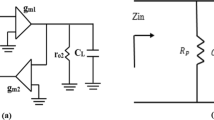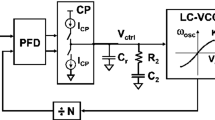Abstract
The paper presents the comparison between two VCO (Voltage Controlled Oscillator) architectures designed in 65 nm CMOS for aerospace applications. In particular, the two VCOs have been designed targeting the 6.25 GHz frequency required in the SpaceFibre standard. The ring oscillator has been designed using three current mode logic stages connected in a loop. Although its performance in terms of low area occupation are attractive, the process variations simulations have demonstrated its inability to generate the target frequency in harsh operating conditions. Instead, the LC-Tank based oscillator, fixing the central frequency with the resonance of the L-C tank, has highlighted a lower influence through Process-Voltage-Temperature simulations on the oscillation frequency. Thanks to varactor-based voltage tuning control, it is able to cover the range from 5.18 to 6.41 GHz. Both architectures are biased with a supply voltage of 1.2 V. The complete layout of the last solution has been designed and its parasitic has been extracted for post-layout simulations. Achieved results are attractive to address the requirements of the new SpaceFibre aerospace standard.
Access this chapter
Tax calculation will be finalised at checkout
Purchases are for personal use only
Similar content being viewed by others

References
Xie L, Wei L (2013) Research on vehicle detection in high resolution satellite images. In: IEEE fourth global congress on intelligent systems
ESA Requirements and Standards Division ESTEC, P.O. Box 299, 2200 AG Noordwijk The Netherlands. Space engineering, SpaceFibre—very high-speed serial link. European Space Agency for the members of ECSS, 2019
Parkers S, Ferrer A et al (2017) SpaceFibre specification draft K1. Copyright 2017, University of Dundee
Ciarpi G, Magazzù G et al (2018) Design of radiation-Hard MZM drivers. In: 20th Italian national conference on photonic technologies (Fotonica 2018), vol 26, pp 1–4
Prinzie J, Christiansen J et al (2017) Comparison of a 65 nm CMOS ring- and LC-oscillator based PLL in terms of TID and SEU sensitivity. IEEE Trans Nucl Sci 64(1):245–252
Ciarpi G, Saponara S et al (2019) Radiation hardness by design techniques for 1 grad TID rad-hard system in 65 nm standard CMOS technologies. In: Application in electronics pervading industry, environment and society, pp 269–276
Palla F, Ciarpi G et al (2019) Design of a high radiation-hard driver for Mach-Zehnder Modulators based high-speed links for hadron collider applications. Nucl Instrum Methods Phys Res Sect A 936:303–304
Voinigescu S (2013) High-frequency integrated circuits. Cambridge University Press
Heydari P (2003) Design and analysis of low-voltage current-mode logic buffers. In: Fourth international symposium on quality electronic design. IEEE
Razavi B (1996) A study of phase noise in CMOS oscillators. IEEE J Solid State Circ 31(3):331–343
Razavi B (1998) RF microelectronics, vol 1. Prentice Hall, Upper Saddle River, NJ
Author information
Authors and Affiliations
Corresponding author
Editor information
Editors and Affiliations
Rights and permissions
Copyright information
© 2020 Springer Nature Switzerland AG
About this paper
Cite this paper
Monda, D., Ciarpi, G., Mangraviti, G., Berti, L., Saponara, S. (2020). Analysis and Comparison of Ring and LC-Tank Oscillators for 65 nm Integration of Rad-Hard VCO for SpaceFibre Applications. In: Saponara, S., De Gloria, A. (eds) Applications in Electronics Pervading Industry, Environment and Society. ApplePies 2019. Lecture Notes in Electrical Engineering, vol 627. Springer, Cham. https://doi.org/10.1007/978-3-030-37277-4_4
Download citation
DOI: https://doi.org/10.1007/978-3-030-37277-4_4
Published:
Publisher Name: Springer, Cham
Print ISBN: 978-3-030-37276-7
Online ISBN: 978-3-030-37277-4
eBook Packages: Physics and AstronomyPhysics and Astronomy (R0)



